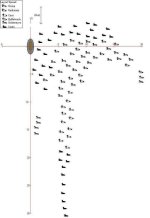I use the longline method.
I have long tarred lines with brass dog snaps on the end that I store on an electrical cord roll (like a big fish reel). My decoys have "droppers" about 3' long with "longline clips" on the end. When I deploy it, I connect sash weights to one end, drop it to the bottom, drift out and attach decoys every so often, then when I get near the other end, attach more longline weights (or add another longline).
Picking it up is the reverse of that, pick up one end, put the weights in a 5 gal pail, one person reels the line in, the other person unclips the decoys and puts them in collapsible barrels.
I learned this setup here on this site and I am a rookie. More experienced folks have better ways of doing it.
Thanks,
Charlie
PS. In addition to Kirk's business, Doctari sells them. I bought a lot of my stuff from them getting started. Although, if you assemble the bits yourself in bulk, you can save a few bucks. It is mostly just commercial fisheries gear.



